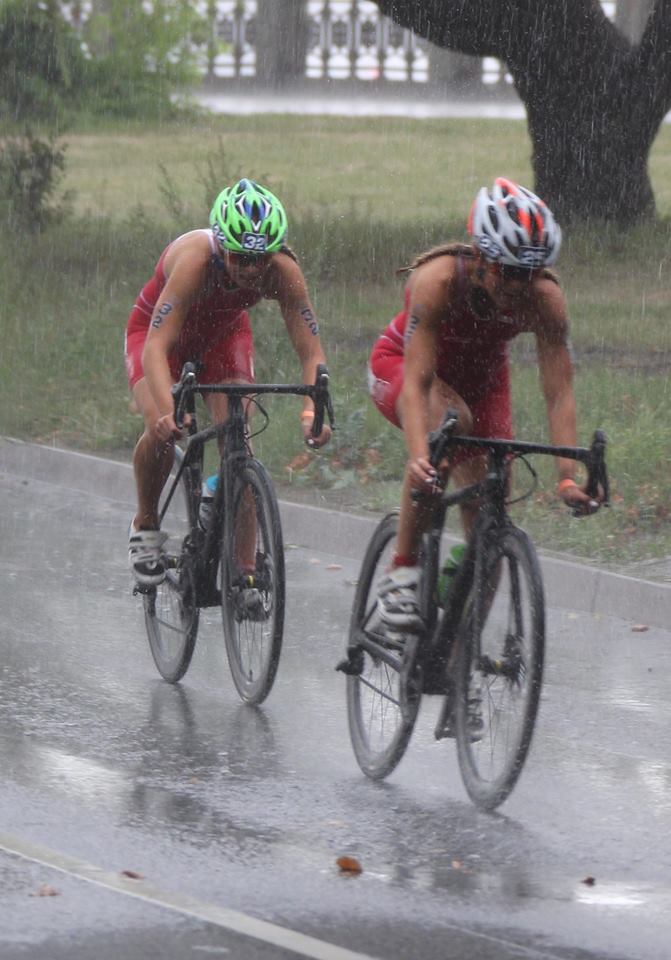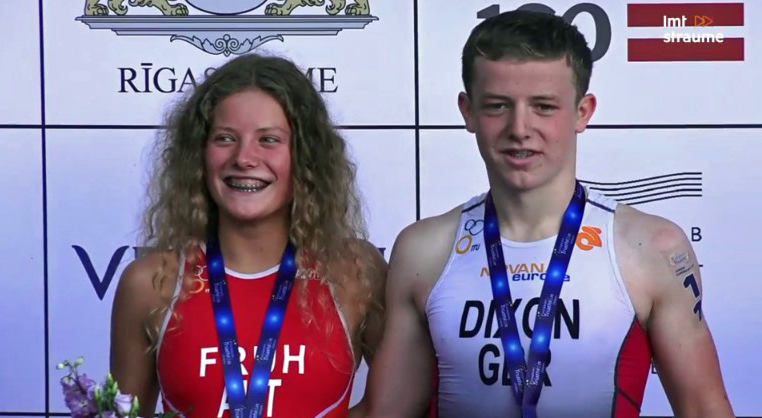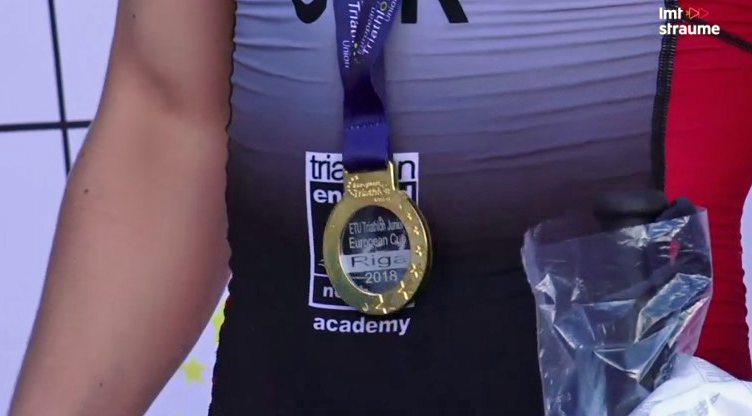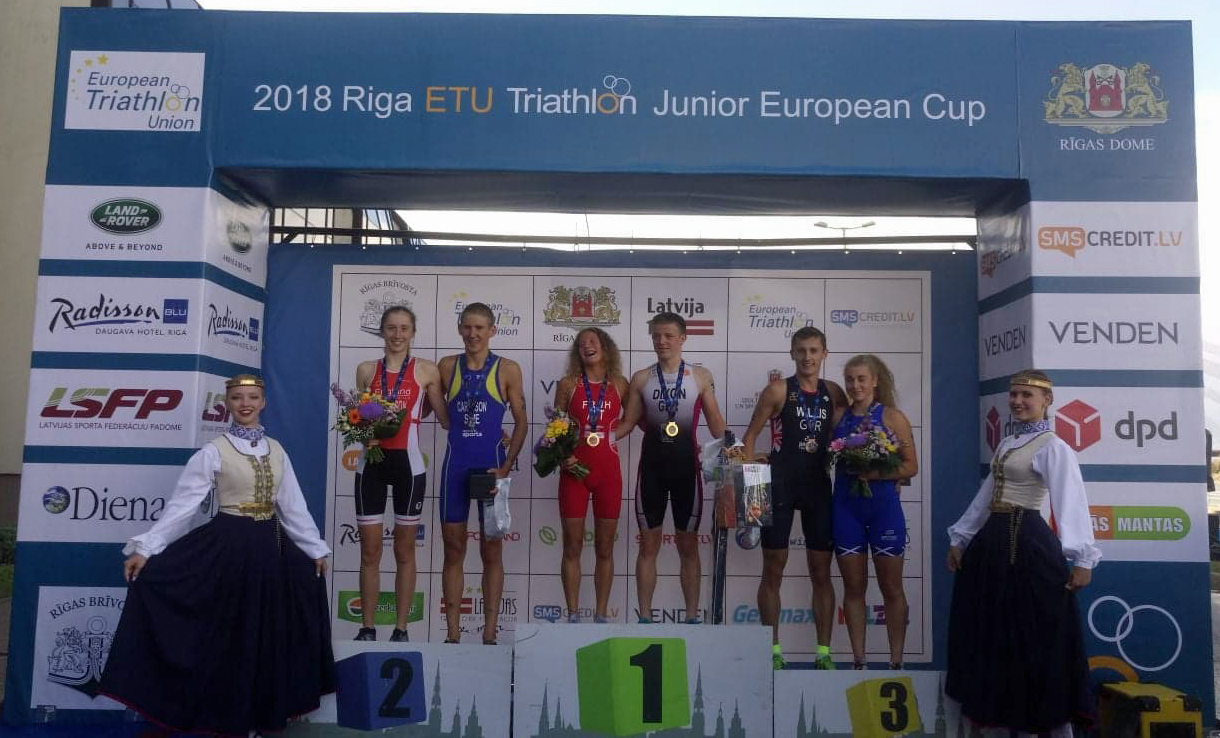Glasgow really grabbed the attention of spectators around the world and while we wait for the final report on the Age Group athletes from ITU’s Olalla Cernuda, we can have a quick look at what happened in Riga, where this weekend we also saw some determined junior athletes bring thrills and spills to the capital of Latvia at the Riga ETU Triathlon Junior European Cup.

The gloriously sunny skies were suddenly darkened as an impressive electric storm swept across the venue, leaving the roads wet and slippery and sadly for some, crashes took them out of the race.
UPDATE
With the sun shining as the athletes took their position on the pontoon, it looked like it would be a great day but in the distance some dark and angry clouds were forming. Alongside the ETU Junior European Cup, athletes from many neighbouring countries had made the journey to this highly popular event to race the Open Event. This ensured that the crowds were huge and ready to cheer our future Olympians.
The Junior Women started in glorious weather and the new course began to take shape and, let’s be honest, it looked rather good!
The backdrop of the city skyline, easy viewing from the host hotel and safe water meant that the LOC had made the right call in their re-design.
A strong initial 200m bit of power saw a clear leader break clear. GB’s Sophia Green was swimming easy and pulling hard through the water to set a commanding pace. A fragmented pack behind her had about 25m to make up as they swam towards the eye-catching bridge that dominates the location.
The non-wetsuit swim was clearly suiting the young Brit and she showed no signs of easing up. In second place but some 20m back, having broken away from the pack, was Alice Patterson, also GB.
As the athletes made their way from the water to T1, Green glanced over her shoulder and must have been delighted to see just how big a lead she had created. Patterson was caught by the pack but with over 30 seconds advantage, it was Green who was first out onto the bike. With the crowds lining Transition, the shouts of encouragement were loud and partisan.
Green’s ride looked like it would be a lonely one if she kept up the power but behind her, just in sight, were the chasing athletes. Then it started to rain. Heavy rain. Nasty rain and with the rain came the risk of a crash on the turns. The lonely place at the front suddenly became a hell as the rainstorm hammered down at the athletes.
Crashes happened, athletes lost places and the 13-strong pack hunted down the leader. Settled into the pack and working sensibly at the front were the two Austrian athletes, Pia Totschnig and Magdalena Früh. Reading the roads well and taking the turns carefully, they systematically set about hunting down Green who was holding her lead and, with the dead turn near to Transition,was able to work out how far ahead she still was.
It was not cold but the rain was of Biblical dimensions. Luckily there was very little wind.
With lighter skies visible in the distance, the athletes continued with their 20k bike as specttors sought refuge in raincoats, plastic bags or under trees but, to their credit, they stayed there to cheer the athletes!
Meanwhile, at the front, Green was able to select the best line as she rode into the rain. The only company she had was the TV motorbike. Her lead remained about the same, as she checked her position at the end of each lap.
Chasing now and working the attack, it was Früh, who was in command of the four as they left the dead turn. Four who had broken away. She had taken Totschnig with her along with Sinead Clark and Freya Thomson, both GBR. Totschnig’s own bike had not arrived due to an airline error and so she was forced to borrow a bike from one of the junior men. Despite this, she was riding well.
Green’s power on the swim and bike was truly remarkable but it was pretty much expected that, having expended so much energy, all on her own, she would be swept aside once the run began. The chasing group had reduced the gap slightly by the end of the 3rd lap and the rain appeared to be easing up a bit.
Amongst that chase group, Früh was certainly on form but Totschnig was showing signs of the form we had seen a couple of years ago. The Austrians would be the major threat to the British athletes.
5 at the front but only three medals. This was looking very good for Team GB, who had dropped out of the top-ten rankings for the Junior Athletes.
On the bell lap, Green started to catch and lap some of the younger and slower athletes. Team GB certainly had some incredible swimmers and cyclists amongst their triathlon teams. Coming into T2, Green had managed to keep some immensely powerful cyclists at bay but the chasing group of four had done well on the final lap and made up more time. As Green racked her bike and put on her running shoes, she could almost hear them breathing down her neck.
Successfully getting out onto the run before them she was 17 seconds ahead of Thomson and Früh, with Totschnig slowing down and laying in 4th.
We saw Früh run recently in Bucharest. She has great speed and suddenly, the turbo-charger kicked in and she eased away from Thomson. Once away, her next target was the blue uniform of Green and by the time they entered the turn point near the finish, the gap was down to just three seconds.
Leaving the blue carpet and the blue leader had changed to a red leader. Green dug deep and held the Austrian in her sights, staying a couple of paces behind but the relentless pace of the Austrian was too much and Green had to resign herself to a lesser medal.
As Green watched Früh pull away, behind her was Thomson and about 75m further back was Totschnig. Was Green going to lose any chance of a medal? Checking to see where Totschnig was, Green accepted that Thomson had better pace and allowed her to lead but using her teammate, she found fresh energy and the two Brits paced each other well to keep ahead of the chasing Austrian.
Behind Totschnig was another Brit, Anabel Morton. She too was running like the wind and could see the red uniform ahead. This was enough for Morton, who simply upped the pace.
Entering the final lap and Green had been dropped by Thomson but the taller Brit simply had no answer to the fast turnover pace of the smaller Früh, who was now well clear and with gold assured.
Green kept the rhythm and maintained her lead over Totschnig, increasing it slightly even but Morton was powering away behind and catching the red uniform with each stride.
The rains had gone and the sun was shining again as Früh, the biggest smile imaginable across her face, took the final steps to the finish line. She had blown the field apart with a truly impressive final run. The gold medal and points were hers. Austria celebrated and Magdalena Früh had done it.
Thomson held on to take silver and a sprint to the finish between Green and Morton was won by the long-time race leader, Sophie Green.
A truly thrilling race, with an impressive performance from Green but final domination by Magdalena Früh.
To watch the race, please click this link.
With the rain now gone and the roads beginning to dry, it was the turn of the Junior Men.
With the rain now gone and the roads beginning to dry, it was the turn of the Junior Men. The rain had gone but was replaced by a stiff breeze that would make the water slap in the swim and make certain sections of the bike a challenge.
A massive line-up made its way down to the pontoon, selecting their positions and focussing on the long way out to the first turn buoy. Taking up almost the entire width of the quay, the athletes turned the water white as they settled into the pecking order and with three distinct leading groups, the 60+ athletes made their way out and along the 750m swim lap.
It was once again Team GB that set the pace with Marcus Dey and Daniel Dixon using their swim power to break away. Dey had been close to the lead in Tartu and is proving to be a key figure in British junior racing. He led up the ramp and in to T1 with Dixon close by. They had created a small but significant gap over the chasing athletes and it looked as if we might see the pair do a “Learmonth and Coldwell” and escape out on the bike course.
The roads were still slick from the rain and the chase pack would have to be careful.
Dey and Dixon worked together to try and keep that chase pack back. Each taking turns at the front to chain-gang and keep the pace up, they were threatened by Sweden’s Andreas Carlsson, who rode powerfully. The Swede joined the leaders who were then caught by another three and it would be this group that would generate more pace. Coming into one of the turns and Dey skidded out but was soon back up on his feet, clicked onto his pedals and trying to catch up.
Carlsson was immensely powerful; breaking away, pushing the pace, breaking the rhythm and this meant there was no rest for Dixon, Cameron Main, Denmark’s Valdemar Solok and Slovenia’s Jan Škrjanc. Having seen one of their group crash out, the leaders were taking no chances on the bends. Instead they were burning up the road as the sun came out and carefully picking their way around the dead-turns. The power shown by them out of the bends was impressive and they worked well together as a team.
With the TV cameras on him, Carlsson took energy fuel on board from his gel and, having been well-trained, tucked the used wrapper into his race suit to avoid a littering penalty. Coaches, take note! This is a great example to all athletes!!
The leading group, pushing so hard, began to overtake athletes. With the dead turns on the course, the chase pack was able to see just what a lead had been created. The pace increased as the roads began to dry under the sun and the speed upped noticeably, as the athletes grew in confidence with the road surface.
Coming into T2 and five athletes would have to race the three laps for just three medals. Carlsson had dropped back a few metres. Main led Dixon out onto the run and Carlsson had some serious catch-up ahead of him as the massive chase pack sped past, 30 seconds back.
Out onto the now very hot run course, the rain a thing of the past, and it was Dixon leading with Main on his shoulder. Solok had edged ahead of Škrjanc and Carlsson was a distant blue uniform. Dixon, without showing any real effort, slowly but surely broke free of his teammate and in the space of just under a minute, had created a gap of 5m.
With the Radisson Hotel dominant on the skyline, it was Dixon, dominant on the run course. Main did his best to hold on but Dixon’s turnover was quick, easy and effective and was pulling him away from the second place.
Solok was unable to bridge the gap and get closer to Main. It looked as if he would have to settle for bronze. The Dane was passing slower athletes on the three-lap course but seemed unaware of the threat behind him.
Way back Matthew Willis was tearing through the pack. Not so far behind, Carlsson was striding long and easy and could see the red uniform of Solok ahead. The Swede just reeled the Dane in; stride by stride he was catching and then passing him, it was Main in view.
As they started the final lap, Dixon was 5 seconds ahead of Main and Carlsson was closing fast, just 12 seconds behind the leader. Solok had seen the medal chance evaporate and more pain was about to hit him as Willis made his move.
Willis could see the tall Carlsson in his blue uniform and that was the focus as Solok was forgotten. Main could do nothing as Dixon extended his lead. Main could do nothing as Carlsson, first breathing hard behind and then alongside and then pulling away, took the Brit’s hoped-for silver medal.
Behind Main now was Willis and with calculated timing, it was Willis whose immense power on the run was unmatched on the day. Dixon had a clear run to the blue carpet, the finish tape, the gold medal and the points. Behind Carlsson had just done enough but with a 13:42 for the 5k, it was Willis who rounded off the podium.
Team GB has certainly done enough this weekend to collect some serious points in the ETU Junior Rankings.
Riga, with its new course has shown us once again that this race one for the diary in 2019 !
Watch the race again by clicking this link.

Gold went to Austria’s Magdalena Früh , silver to Great Britain’s Freya Thomson and bronze to her teammate, Sophia Green.

Amongst the men, a superb final run from Daniel Dixon took him into the lead.

Andreas Carlsson, fifth here last year, imprved greatly to take the silver, with Great Britain rounding off a really succesful weekend of racing, with a massive points haul that will shake up the Junior Rankings, as Matthew Willis took bronze.

Thanks to Straume.lmt.lv for their screen captures, to Jorge García for the combined podium and to Christopher Totschnig for that photo of the Junior Women in the rain.
Related Event: 2018 Riga ETU Triathlon Junior European Cup
| Results: Junior Men | |||
|---|---|---|---|
| 1. | Daniel Dixon | GBR | 00:57:41 |
| 2. | Andreas Carlsson | SWE | 00:57:46 |
| 3. | Matthew Willis | GBR | 00:57:52 |
| 4. | Cameron Main | GBR | 00:57:54 |
| 5. | Valdemar Solok | DEN | 00:58:15 |
| 6. | Jan Skrjanc | SLO | 00:58:42 |
| 7. | Marcus Dey | GBR | 00:59:17 |
| 8. | Martin Semerad | CZE | 00:59:27 |
| 9. | Elai Izhak Chaski | ISR | 00:59:40 |
| 10. | Artjoms Gajevskis | LAT | 00:59:42 |
| Results: Junior Women | |||
|---|---|---|---|
| 1. | Magdalena Früh | AUT | 01:03:51 |
| 2. | Freya Thomson | GBR | 01:04:33 |
| 3. | Sophia Green | GBR | 01:04:55 |
| 4. | Annabel Morton | GBR | 01:04:57 |
| 5. | Pia Totschnig | AUT | 01:04:59 |
| 6. | Daniela Leitāne | LAT | 01:05:01 |
| 7. | Hollie Elliott | GBR | 01:05:29 |
| 8. | Sinead Clark | GBR | 01:05:30 |
| 9. | Rosie Allen | GBR | 01:05:42 |
| 10. | Imogen Moroney | GBR | 01:05:45 |








